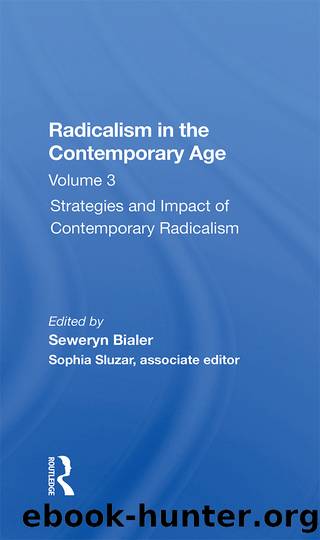Radicalism in the Contemporary Age, Volume 3: Strategies and Impact of Contemporary Radicalism by Seweryn Bialer & Sophia Sluzar

Author:Seweryn Bialer & Sophia Sluzar [Bialer, Seweryn & Sluzar, Sophia]
Language: eng
Format: epub
Tags: Political Science, General
ISBN: 9781000308907
Google: hQWdDwAAQBAJ
Goodreads: 51980434
Publisher: Routledge
Published: 2019-06-10T00:00:00+00:00
Organization
Despite their abandonment of much classical Leninist strategy, the contemporary PCF and PCI retain a strong drive to develop powerful and autonomous organizations to serve as instruments for the implementation of their strategic interests. This should be no surprise. Not only is it explicable by the force of tradition, but it is also a direct function of the nature of the postwar strategy itself. Although the parties differ in the ways they pursue political and social alliances, their common strategy requires that they construct organizations powerful enough to carry out a broad range of activities. But there are, of course, significant differences in the characteristics of the two parties' organizations, reflecting the differences in strategic implementation.
Throughout the postwar period, with the possible exception of the worst years of the Cold War,85 the PCI has consistently sought to develop a more open and flexible organizational structure and set of operating practices than has the PCF, The need for the Italian Party to seek a wider set of political and social alliances, to develop a more extensive social presence in the society, and hence to accept greater ambiguity and instability in its relations with its environment, has had its analogues in the Party's relationship to its own members. Far more than the PCF, the PCI has had to develop an organization which would avoid the dangers of sectarian behavior so common to the experience of the communist parties of Europe. While the PCF remains a hybrid cadre party,86 the PCI has been, since 1945, a communist mass party.
Perhaps the most revealing organizational difference between the PCF and the PCI is in their approach to three related issues: how many members they should have, who these members should be, and where they should come from. The PCI has consistently striven for a larger, more socially and territorially diverse membership than the PCF. Throughout most of the postwar period the Italian Party has had a membership about four or five times as large as that of the French Party. Immediately after the war, in the wake of the enthusiasm generated by the role played by the parties in the French and Italian Resistance, both parties expanded their membership dramatically from the prewar years. Though the figures are somewhat unreliable, the PCF seems to have attained a membership of almost a million, and the PCI of well over 2 million. Both parties had mass organizations, which varied considerably in the degree of commitment and level of activity of their members. With the coming of the Cold War, however, a significant difference between the two organizations developed. While the PCF lost more than half its membership, the PCI appears to have continued to grow, reaching its peak only in 1954. Since that time the membership of the PCF, according to Kriegel, has varied from about 250,000 to 400,000, that of the PCI from about 1,500,000 to 1,650,000. The data available indicate that both parties suffered some membership decline in the 1960s but appear to have reversed this trend in recent years.
Download
This site does not store any files on its server. We only index and link to content provided by other sites. Please contact the content providers to delete copyright contents if any and email us, we'll remove relevant links or contents immediately.
| Anarchism | Communism & Socialism |
| Conservatism & Liberalism | Democracy |
| Fascism | Libertarianism |
| Nationalism | Radicalism |
| Utopian |
The Secret History by Donna Tartt(18157)
The Social Justice Warrior Handbook by Lisa De Pasquale(11951)
Thirteen Reasons Why by Jay Asher(8451)
This Is How You Lose Her by Junot Diaz(6435)
Weapons of Math Destruction by Cathy O'Neil(5829)
Zero to One by Peter Thiel(5488)
Beartown by Fredrik Backman(5353)
The Myth of the Strong Leader by Archie Brown(5237)
The Fire Next Time by James Baldwin(5016)
How Democracies Die by Steven Levitsky & Daniel Ziblatt(4953)
Promise Me, Dad by Joe Biden(4908)
Stone's Rules by Roger Stone(4857)
100 Deadly Skills by Clint Emerson(4690)
A Higher Loyalty: Truth, Lies, and Leadership by James Comey(4550)
Rise and Kill First by Ronen Bergman(4545)
Secrecy World by Jake Bernstein(4388)
The David Icke Guide to the Global Conspiracy (and how to end it) by David Icke(4379)
The Farm by Tom Rob Smith(4323)
The Doomsday Machine by Daniel Ellsberg(4245)
